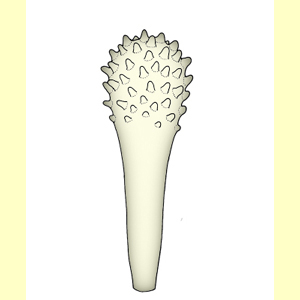
This feature relates to the presence of few to many branches (or protuberances) on the caulocystidia, irrespective of the overall shape (Caulocystidia shape) and any apical modifications (Caulocystidia apex shape). Branches can be apical, or along the length of caulocystidia.
Choose this state if: there are branches present which are short (nodules) and usually relatively dense. The nodules may occur only on the apical portion of the cystidium. Cystidia with numerous small apical nodules are also described as Rotalis-type broom cells (celles or cystides en brosse). Other terms for this state are verrucose, spinulose and echinate (with acute-tipped protuberances).
The term 'acanthocyst' is applied particularly in Mycena to thin-walled nodulose cystidia, which can have a mixture of short and long branches on the body of the cystidium. For such cystidia, choose this state and diverticulate.
